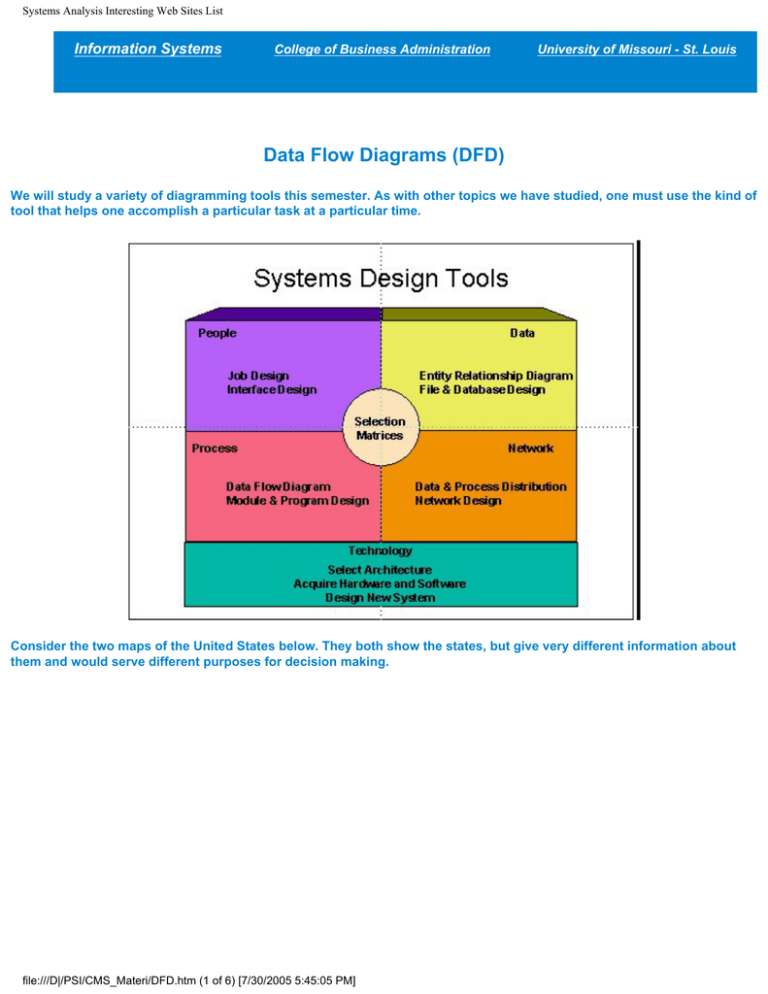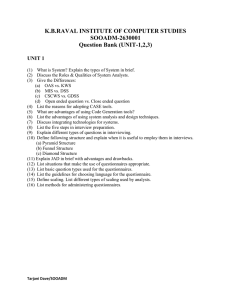
Systems Analysis Interesting Web Sites List
Information Systems
College of Business Administration
University of Missouri - St. Louis
Data Flow Diagrams (DFD)
We will study a variety of diagramming tools this semester. As with other topics we have studied, one must use the kind of
tool that helps one accomplish a particular task at a particular time.
Consider the two maps of the United States below. They both show the states, but give very different information about
them and would serve different purposes for decision making.
file:///D|/PSI/CMS_Materi/DFD.htm (1 of 6) [7/30/2005 5:45:05 PM]
Systems Analysis Interesting Web Sites List
file:///D|/PSI/CMS_Materi/DFD.htm (2 of 6) [7/30/2005 5:45:05 PM]
Systems Analysis Interesting Web Sites List
Data Flow Diagrams (DFDs), as the name suggests, illustrates the flow of information in a system. They are hardware
independent and they do not reflect decision points. Rather they demonstrate the information and how it flows between
specific processes in a system. They provide one kind of documentation for our reports.
Naming Conventions:
Data Flows: name of the packet of information (arcs)
Data Stores: name of the data stored there (rectangle)
Transformations: name of the activity (bubbles)
Origins and Destinations: name of producers, customers, etc. in the environment (boxes)
Since they generally describe a complex system, there are layers of DFD's that show increasingly more information about
the processes. Consider the diagram below.
file:///D|/PSI/CMS_Materi/DFD.htm (3 of 6) [7/30/2005 5:45:05 PM]
Systems Analysis Interesting Web Sites List
These diagrams show a group of related sets:
Context Diagram: This is the highest level and represents the overall system and its interaction with its
environment
Level 0 Diagram: This shows the major subsystems and their interactions
file:///D|/PSI/CMS_Materi/DFD.htm (4 of 6) [7/30/2005 5:45:05 PM]
Systems Analysis Interesting Web Sites List
Level x Diagram: Shows the processes that make up each of the major subsystems
Level x.y Diagram: Shows detail of the above diagrams
Each bubble on one level gets "exploded" to show the detail at another level. These pairs are referred to as parent-child
pairs. It is important to keep balance between the individual parents and their children.
Numbering: Each process in Level 0 gets a number. Each child inherits the number. Bubbles on the child dfd maintain that
number, and begin their numbering as a number after the decimal point. These are unique numbers.
When to stop:
Each process is a single decision or calculation or a single database operation, such as retrieve, update, create,
delete or read.
Each data store represents data about a single entity such as a customer, employee, product or order.
The system user does not care to see any more detail or when you and other analysts have dcoumented sufficient
detail to do subsequesnt systems development tasks.
file:///D|/PSI/CMS_Materi/DFD.htm (5 of 6) [7/30/2005 5:45:05 PM]
Systems Analysis Interesting Web Sites List
Every data flow does not need to be split further to show that different data are handled in different ways.
You believe that you have shown each business form or transaction, computer screen and report as a single data
flow.
You believe there is a separate process for each choice on all lowest-level menu options for the system.
Class Examples of the Registration Process:
Data Flow Diagram (DFD) Example (Context and Level 0 Diagrams).
Data Flow Diagram (DFD) Example (Level 4 Explosion).
An example of a data flow diagram for a library is also available on the Internet.
| UM-St. Louis Home Page | College of Business Page | IS Home Page | Analysis Home Page |
This page was last modified on: undefined
URL: undefined
Page Owner: Professor Sauter (Vicki.Sauter@umsl.edu)
© Vicki L. Sauter. All rights Reserved.
file:///D|/PSI/CMS_Materi/DFD.htm (6 of 6) [7/30/2005 5:45:05 PM]





